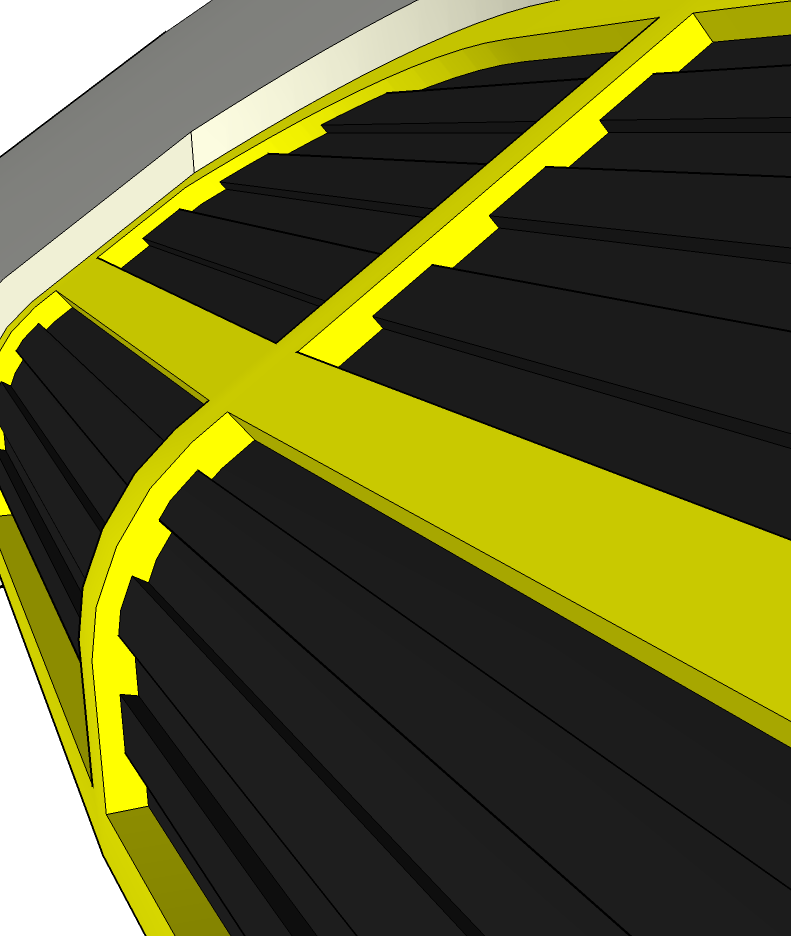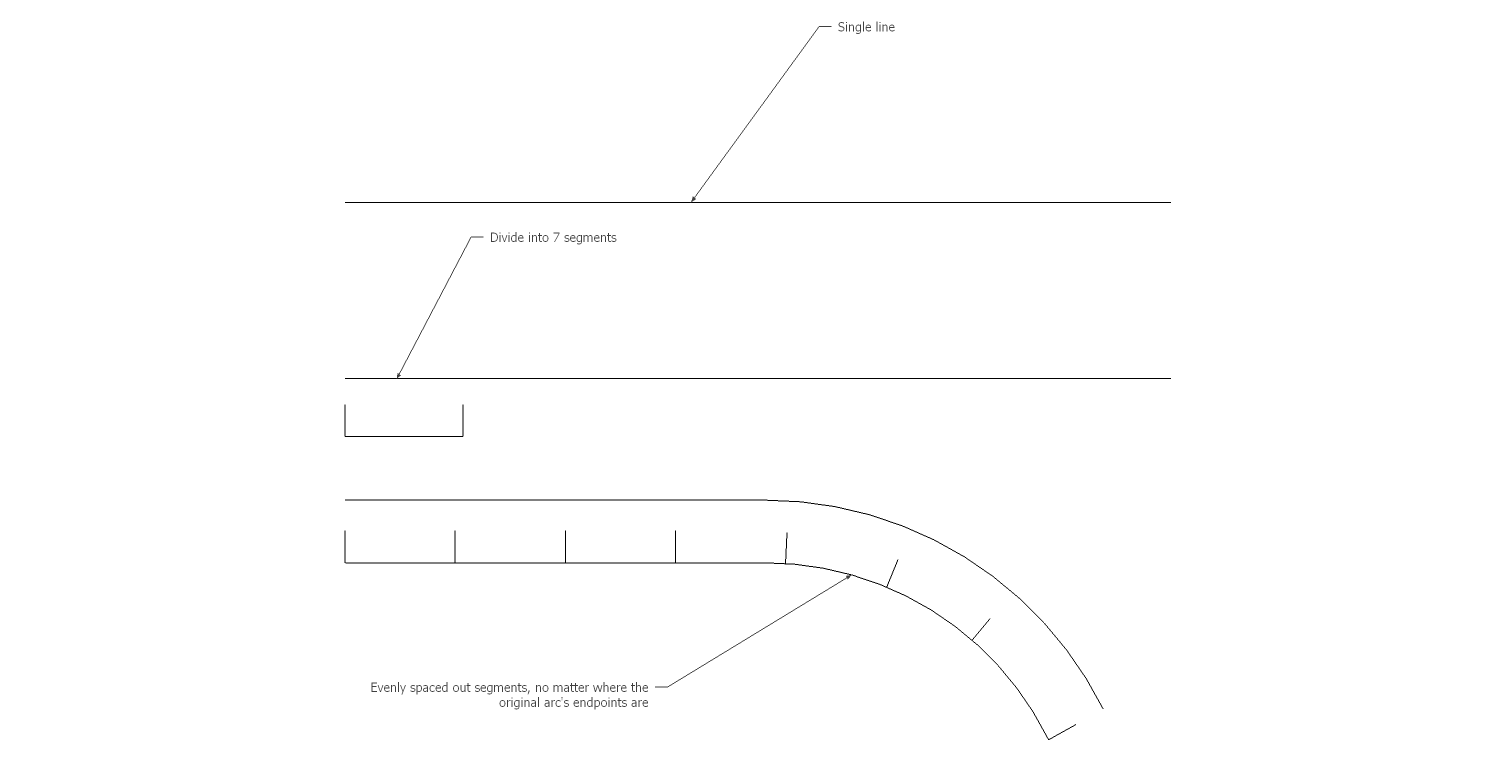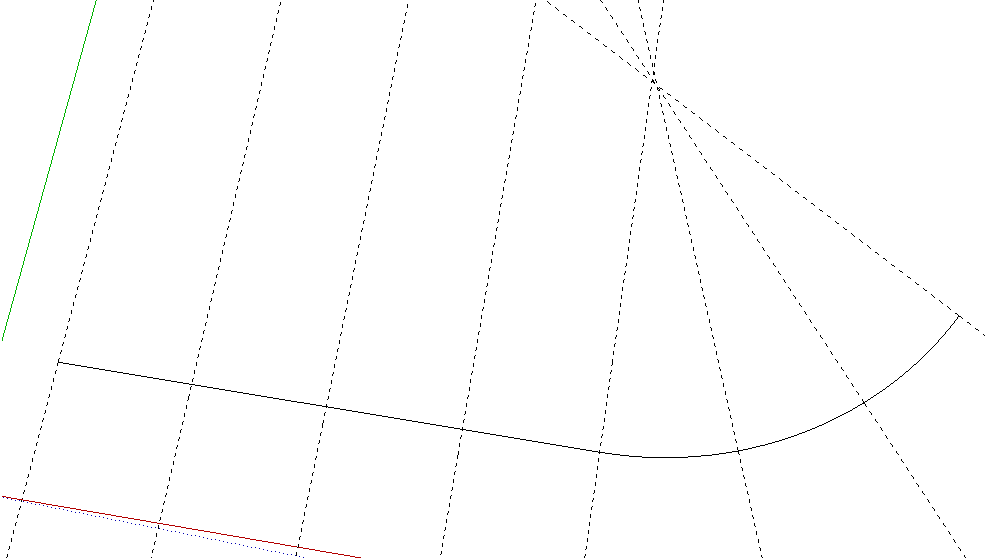Dividing combined shape: line + arc
-
So, I've got this little problem. I've got an arc which I want to divide into a certain amount of smaller segments, ignoring the original endpoints of the arc.
The divide tool of SU only works on single, non arcing lines: if I want a line segmented into seven equal parts, I hit "divide", enter 7 and we're done.
But I now have a line that is connected to a small arc with 4 segments, but I still want to have 7 segments, evenly spaced out across that combined shape. Any ideas on how to accomplish this? I can imagine it's got something to do with using the Weld tool... -
Look up polydivider. I think you must change to polyline first.
-
Hi, BorgMan:
If you have Fredo6's Bezierspline suite, and Weld, you can weld the two together, select the entity, right click, convert to Polyline Segmentor, a parameter box comes up to select the number of segments you desire. So I drew an arc with 12 segments and a line with one segment, welded them, right clicked found Convert to: selected Polyline Segmentor, input 5 and the selection changed to 5 segments.EDIT: it would be nice if you could right click select entity info and edit the segments there. I don't know why it doesn't.
-
@borgman said:
...The divide tool of SU only works on single, non arcing lines...
That is actually not true: the divide commant also works on circle, polygon and arc entities, too (but they need to be these entities, not welded or even not welded just connected line segments).
So true that in your particular case, when it is an arc andsome other line segments, this will not work (and see bottom line: it would probably not suite your needs anyway)...
@mitcorb said:
...it would be nice if you could right click select entity info and edit the segments there. I don't know why it doesn't.
Probably because these curves are not native SU entities...
Also, back to my first statement... If you change the segment count of an arc from 12 to 7, there will be 7 true, straight segments. If you divide it to 7 however, it will change to 14 segments and each, divided part will consist of 2, welded segments - so SU rounds up (or when thatis closer, down) the total segment count of an arc (circle, polygon) so that is divisible by the number you want to divide it.
-
Thanx for the heads up guys! mitcorb, to be clear I already have a shape which needs to be divided and I don't want it to take on another shape. I just tested the plugin and it does change the shape you're working with. I can always measure how far every endpoint is from the other and when I vind a curve on my way just substract what I had before that end point from the total. But that means a lot of extra work


-
Hi
Your image suggests that you want to match the number of segments of one curve to the other. I believe offset will do that? Select the item, press F on the keyboard or select the Offset icon. You can specify the distance for the offset or visually drag it. When drawing the curve you of course can specify the number of segments simply e.g. by activating the Arc tool, type in the number thus: 12s and Enter. -
Haha, no, I don't want to match it. Observe the attached image please

As you can see, there's a roster on top and in the curve. That roster on top was made by dividing a single line into 7 segments. I wanted to do the same for the curve. As said, it already has a fixed shape, I just want to add endpoints on that shape, spaced evenly into 7 segments, so that I can have the same numer of blocks that make up the roster and be done with it. Now, I had to right click the arc to know how long it was (let's say 2 meters), calculate how much that was when divided into 7 (0,28) and then manually divide it. When I reached the arc I had to calculate again. Let's say that from the 0,28 meters a segment is long, the arc starts at 0,12. That means that I substract 0,12 from 0,28, leaving me with 0,16 meters to go into the arc. Continue on. That is time consuming


-
Hi:
I am not sure of your term "roster" unless it is from Latin "rostrum", meaning nose, or beak. But, then, I am not seeing anything in the illustration resembling that definition, except that short segment at upper middle. This may be a common term in your language, perhaps a Nordic language?
At any rate, perhaps someone else would like to weigh in? -
The English word 'roster' means a list [usually of names against duties etc] - sometimes called a 'roll'; 'roster' comes from a similar Dutch word ['rooster'] which also means a list [written on on 'gridded' paper], and originally coming from the 'gridiron' which is used to 'roast' food = a 'roaster' / 'rooster' >> 'roster' ...
An unusual N. English slang word 'roster' means a 'rascal'...
I too can see nothing in this view posted that I can interpret as a 'roster' at all... so please explain another way with other words...

Do you me a 'roll' ? -
Oh dear... In dutch, a "rooster" is also something you put in front of something else to protect it, for example a fan. It makes sure you don't get hurt. In my image, however, I meant the blackish objects
 I'll post another reference of what I want to do...
I'll post another reference of what I want to do...

-
Divide a straight line and bend it maybe?

-
But the curve to bend it around would need to be equally divided up so then you have the form anyway ?

-
@tig said:
The English word 'roster' means a list [usually of names against duties etc] - sometimes called a 'roll'; 'roster' comes from a similar Dutch word ['rooster'] which also means a list [written on on 'gridded' paper], and originally coming from the 'gridiron' which is used to 'roast' food = a 'roaster' / 'rooster' >> 'roster' ...
An unusual N. English slang word 'roster' means a 'rascal'...
I too can see nothing in this view posted that I can interpret as a 'roster' at all... so please explain another way with other words...

Do you me a 'roll' ?You old 'roster' TIG

-
Would this work?

-
-
OK. So here are the steps I used.
Started with a line whose length is easily divided by 7. I used 21.
Place a crossing guideline at 4/7ths of the length (12 in this case) to provide a snap-to point.
Get the Radial Bend tool from FredoScale. Start the bend at the intersection of the line and guideline. Set the Number of Slices to something easily divided by three. (the remaining 3/7ths of the line) I used 30 to get a smooth curve but it wouldn't have to be that many.
Guidelines were placed at increments of 3 along the straight line and every 10 endpoints along the curve. -
All I can say here is: Please excuse my density?
-
@mitcorb said:
All I can say here is: Please excuse my density?
Izzat 'cause a confoozed ya? If I did, I probably confused the OP, too.
-
@dave r said:
Izzat 'cause a confoozed ya? .....
Hi Dave, no, not really. But you worked out an exceptional case where the connection between arc and edge remains one of the endpoints (at n segments from start) in the result.
Since SU works with segments, not true circles and arcs it's a tricky thing to tackle. In general you just have to give up that connecting endpoint (arc/edge)
Try this: edge length 5450mm / tangent arc (R=4310mm, 12 segments) on chord length ~4107mm. So you start with 13 segments. Make that shape into say 6 equal segments.
The thing is you have to decide what will remain close to the original shape.
At least you need to let go of their original (edge/arc) mutual endpoint. -
Gerrit, I agree that you need to let go of the original edge/arc.
I think my method ought to work in most cases because I'm dividing the straight edge to suit the required number of division and then diving the part that gets bent so there are an equal number of shorter segments between divisions. the downside that I see is that the plugin allows one to enter and angle of deviation from the beginning of the arc to the end but not a radius. One would need to reverse engineer the length of the edge based on a radius but knowing the central angle of the arc would be helpful anyway because you could divide the arc's angle as needed to get the required number of divisions.
So, is there a plugin that could take a selected arc and report the central angle?
Advertisement







